
“Sherlock’s Last Case” is an as-yet untold account of Sherlock Holmes (versatilely played by Kevin McKillip) and his trusted companion Dr. Watson (Joe Foust). Throughout, we learn more about their association, which is not as elementary as it might seem . This is not a murder mystery or a whodunit but fits more neatly into the genre of suspense; because the protagonist is in some danger and we don’t know what will happen to him next.
The performance takes place in the year 1897 and unfolds in Holmes’s flat at 221B Baker Street, in London. Despite the somewhat slow beginning (when the pieces of the story start to come together), the first act deserves an “A” all by itself. What a fascinating premise! And no, I won’t give it away, except to say that Holmes acts like a pompous backside (if you will). His arrogance grates on everybody.
The plot is cleverly devised in the way that it introduces us to each of the five characters. When Holmes’s housekeeper and landlady Mrs. Hudson (Belinda Bremner) is suddenly called away to attend her grandfather’s funeral, Holmes is at a total loss. His fruit bowl is empty; his favorite liquor is absent; he has nobody to answer the door for him. Though his archenemy Moriarty is dead, the man’s descendants are still very much alive. Holmes receives a letter from Moriarty’s son Simeon threatening his life. He subsequently receives a visit from Moriarty’s daughter Liza (Lydia Hiller), who explains that her brother is serious about the murder, and she would like very much to stop him. Inspector Lestrade (René Ruelas), of Scotland Yard, is called in to help in the search for the prospective killer. All the while, Holmes shares his innermost thoughts with Watson, who offers his wise counsel to help solve the case.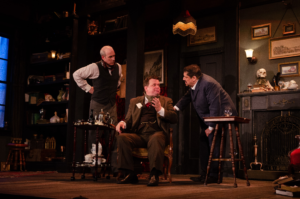
Throughout the intermission, the audience kept hanging as to where the story will go next. The intricacies of the plot and the palpable horror at this stage of the performance are ingenious.
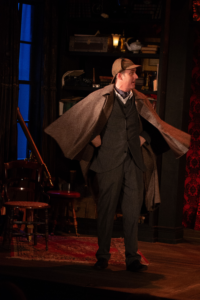 Now it’s on to the second act, which has some good spots but is mostly too far-fetched and contrived. The best parts are its twists and turns, but those are also its greatest faults. There are too many of them, and most seem post hoc and unsatisfactory. While the playwright Charles Marowitz displays cleverness here, many of the twists take away from Holmes’s character rather than add to his credibility. There are moments when he is more of a Harry Houdini—and that can be a good thing—but there are also moments of inconsistency from the protagonist richly developed by Sir Arthur Conan Doyle in his mystery novels.
Now it’s on to the second act, which has some good spots but is mostly too far-fetched and contrived. The best parts are its twists and turns, but those are also its greatest faults. There are too many of them, and most seem post hoc and unsatisfactory. While the playwright Charles Marowitz displays cleverness here, many of the twists take away from Holmes’s character rather than add to his credibility. There are moments when he is more of a Harry Houdini—and that can be a good thing—but there are also moments of inconsistency from the protagonist richly developed by Sir Arthur Conan Doyle in his mystery novels.
As the narrative becomes more and more campy, the performance becomes less convincing. Its climax is explained but not clearly demonstrated. When the inspector is called out of the room one too many times, the story fails to be believable. Then there are the idiosyncratic happenstances that lead to eyerolls. What a jolly good idea to fire a gun on Guy Fawkes Day, when firecrackers fill the air in commemoration of the foiled Gunpowder Plot to blow up Parliament! What a jolly good surprise to bring Queen Victoria and her royal tributes into the storyline! While my guest thought that the plot twists were fun, we both agreed that the story didn’t hang together as it should have. With so many improbable and coincidental components in a row, all I could think of was, “What are they going to throw at me next?”
The play asks each one of us to look into ourselves to determine which sorts of transgressions are forgivable and which ones are not. I would argue that another fault with the script has to do with the playwright’s ideas about forgiveness and its power to make people whole. Marowitz may be a better person than I am, but he has done a great disservice to Holmes’s super-sleuth personality regarding how he deals with such matters. There is a saying: “Keep your friends close and your enemies closer.” But how close is too close? When is revenge sweet, and when is it not so much?
The acting is beautiful. The director Janice L. Blixt has done a fine job bringing this thriller to a receptive audience. I want to congratulate Angela Weber Miller for the scenic design and Wendy A. Huber and Margaret Garofalo for their props design. Both the vintage and spooky sets work extremely well. Costuming by Rachel Lambert is authentic to the era, and I especially liked Mrs. Hobson’s dress. However, the great attention to detail in the production department doesn’t make up for the over-the-top script, which cannot be easily forgiven.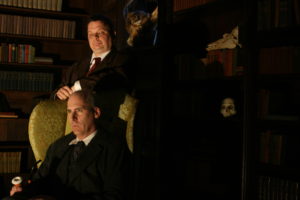
If the first act hadn’t been so well done, then the fall in the second act would not have been so steep. In sum, “Sherlock’s Last Case” is a disappointment that doesn’t live up to its great promise.
“Sherlock’s Last Case” is produced by First Folio Theatre, located at the Mayslake Peabody Estate, 1717 31st Street (off Route 83), in Oak Brook, Illinois. Free parking is available on the grounds.
Performances run through November 3, 2019, according to the following schedule:
Thursdays 3:00 p.m.
Fridays 8:00 p.m.
Saturdays 4:00 p.m. and 8:00 p.m.
Sundays 3:00 p.m.
An additional Sunday performance is on November 3rd at 7:30 p.m.
Regular-priced tickets are $34 on Wednesdays and Thursdays (seniors and students are $29)
$44 on Fridays, Saturdays, and Sundays (seniors and students are $39)
Special $10 tickets are available for children 14 and under for all season shows.
Tickets are on sale now and may be purchased by calling the box office at 630-986-8067 or online at www.firstfolio.org.
To see what others are saying, visit www,theatreinchicago.com, go to Review Round-Up and click at “Sherlock’s Last Case”


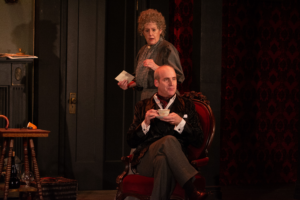
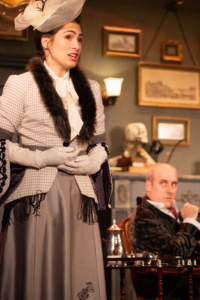




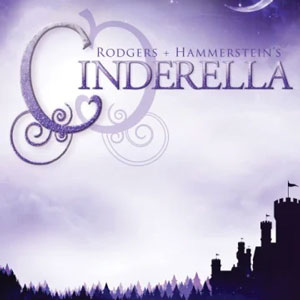
More Stories
” A Christmas Carol” reviewed by Paul Lisnek
“Pilot Island & Her Keepers” reviewed by Julia W. Rath
“Rodgers and Hammerstein’s Cinderella”